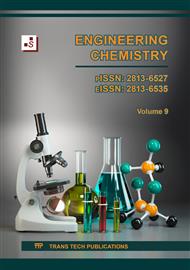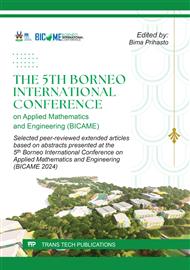[1]
S. Prifiharni et al., "Extract sarampa wood (Xylocarpus Moluccensis) as an eco-friendly corrosion inhibitor for mild steel in HCl 1M," Journal of the Indian Chemical Society, vol. 99, no. 7, Jul. 2022.
DOI: 10.1016/j.jics.2022.100520
Google Scholar
[2]
P. C. Okafor, X. Liu, and Y. G. Zheng, "Corrosion inhibition of mild steel by ethylamino imidazoline derivative in CO2-saturated solution," Corrosion Science, vol. 51, no. 4, p.761–768, Apr. 2009.
DOI: 10.1016/j.corsci.2009.01.017
Google Scholar
[3]
R. Landolfo, L. Cascini, and F. Portioli, "Modeling of metal structure corrosion damage: A state of the art report," Sustainability, vol. 2, no. 7, p.2163–2175, 2010.
DOI: 10.3390/su2072163
Google Scholar
[4]
M. G., & G. N. D. Fontana, Corrosion Engineering McGraw-Hill book Company. New York, 1987.
Google Scholar
[5]
K. Hu, J. Zhuang, J. Ding, Z. Ma, F. Wang, and X. Zeng, "Influence of biomacromolecule DNA corrosion inhibitor on carbon steel," Corrosion Science, vol. 125, p.68–76, Aug. 2017.
DOI: 10.1016/j.corsci.2017.06.004
Google Scholar
[6]
C.G. Soares, "SPECIAL ISSUE ON IMAM 2007." [Online]. Available: https://www.researchgate.net/publication/278353484
Google Scholar
[7]
W. Xu et al., "Corrosion of rail tracks and their protection," Corrosion Reviews, vol. 39, no. 1. De Gruyter Open Ltd, p.1–13, Feb. 01, 2021.
DOI: 10.1515/corrrev-2020-0069
Google Scholar
[8]
I. Radojčić, K. Berković, S. Kovač, and J. Vorkapić-Furač, "Natural honey and black radish juice as tin corrosion inhibitors," Corrosion Science, vol. 50, no. 5, p.1498–1504, May 2008.
DOI: 10.1016/j.corsci.2008.01.013
Google Scholar
[9]
Z. D. I. Esih, "Technology of Corrosion Protection," 1990.
Google Scholar
[10]
H. Ashassi-Sorkhabi and E. Asghari, "Effect of hydrodynamic conditions on the inhibition performance of l-methionine as a 'green' inhibitor," Electrochimica Acta, vol. 54, no. 2, p.162–167, Dec. 2008.
DOI: 10.1016/j.electacta.2008.08.024
Google Scholar
[11]
X. Li, S. Deng, G. Mu, H. Fu, and F. Yang, "Inhibition effect of nonionic surfactant on the corrosion of cold rolled steel in hydrochloric acid," Corrosion Science, vol. 50, no. 2, p.420–430, Feb. 2008.
DOI: 10.1016/j.corsci.2007.08.014
Google Scholar
[12]
J. Aljourani, M. A. Golozar, and K. Raeissi, "The inhibition of carbon steel corrosion in hydrochloric and sulfuric acid media using some benzimidazole derivatives," Materials Chemistry and Physics, vol. 121, no. 1–2, p.320–325, May 2010.
DOI: 10.1016/j.matchemphys.2010.01.040
Google Scholar
[13]
M. Finšgar, S. Fassbender, F. Nicolini, and I. Milošev, "Polyethyleneimine as a corrosion inhibitor for ASTM 420 stainless steel in near-neutral saline media," Corrosion Science, vol. 51, no. 3, p.525–533, Mar. 2009.
DOI: 10.1016/j.corsci.2008.12.006
Google Scholar
[14]
Q. B. Zhang and Y. X. Hua, "Corrosion inhibition of mild steel by alkylimidazolium ionic liquids in hydrochloric acid," Electrochimica Acta, vol. 54, no. 6, p.1881–1887, Feb. 2009.
DOI: 10.1016/j.electacta.2008.10.025
Google Scholar
[15]
M. Seter, M. J. Thomson, J. Stoimenovski, D. R. MacFarlane, and M. Forsyth, "Dual active ionic liquids and organic salts for inhibition of microbially influenced corrosion," Chemical Communications, vol. 48, no. 48, p.5983–5985, May 2012.
DOI: 10.1039/c2cc32375c
Google Scholar
[16]
D. Gopi, K. M. Govindaraju, and L. Kavitha, "Investigation of triazole derived Schiff bases as corrosion inhibitors for mild steel in hydrochloric acid medium," Journal of Applied Electrochemistry, vol. 40, no. 7, p.1349–1356, Jul. 2010.
DOI: 10.1007/s10800-010-0092-z
Google Scholar
[17]
E. Kowsari, M. Payami, R. Amini, B. Ramezanzadeh, and M. Javanbakht, "Task-specific ionic liquid as a new green inhibitor of mild steel corrosion," Applied Surface Science, vol. 289, p.478–486, Jan. 2014.
DOI: 10.1016/j.apsusc.2013.11.017
Google Scholar
[18]
D. Bizuayehu, M. Atlabachew, and M. T. Ali, "Determination of some selected secondary metabolites and their invitro antioxidant activity in commercially available Ethiopian tea (Camellia sinensis)," SpringerPlus, vol. 5, no. 1, Dec. 2016.
DOI: 10.1186/s40064-016-2056-1
Google Scholar
[19]
N. Moonrungsee, N. Peamaroon, A. Boonmee, S. Suwancharoen, and J. Jakmunee, "Evaluation of tyrosinase inhibitory activity in Salak (Salacca zalacca) extracts using the digital image-based colorimetric method," Chemical Papers, vol. 72, no. 11, p.2729–2736, Nov. 2018.
DOI: 10.1007/s11696-018-0528-1
Google Scholar
[20]
M. S. M. Saleh, M. J. Siddiqui, S. Z. M. Soad, S. Murugesu, A. Khatib, and M. M. Rahman, "Antioxidant and α-glucosidase inhibitory activities and gas chromatography-mass spectrometry profile of salak (Salacca zalacca) fruit peel extracts," Pharmacognosy Research, vol. 10, no. 4, p.385–390, Oct. 2018.
DOI: 10.4103/pr.pr_7_18
Google Scholar
[21]
H. Hassannejad and A. Nouri, "Sunflower seed hull extract as a novel green corrosion inhibitor for mild steel in HCl solution," Journal of Molecular Liquids, vol. 254, p.377–382, Mar. 2018.
DOI: 10.1016/j.molliq.2018.01.142
Google Scholar
[22]
M. J. B. Kabeyi and O. A. Olanrewaju, "Biogas Production and Applications in the Sustainable Energy Transition," Journal of Energy, vol. 2022, p.1–43, Jul. 2022.
DOI: 10.1155/2022/8750221
Google Scholar
[23]
M. M. Kamel, A. A. S. Fouda, S. M. Rashwan, and O. Abdelkader, "Paprika extract: a green inhibitor for mitigating carbon steel disintegration in 1 M HCl pickling solution," Green Chemistry Letters and Reviews, vol. 14, no. 4. Taylor and Francis Ltd., p.598–609, 2021.
DOI: 10.1080/17518253.2021.1985173
Google Scholar
[24]
G. Ji, S. Anjum, S. Sundaram, and R. Prakash, "Musa paradisica peel extract as green corrosion inhibitor for mild steel in HCl solution," Corrosion Science, vol. 90, p.107–117, Jan. 2015.
DOI: 10.1016/j.corsci.2014.10.002
Google Scholar
[25]
J. C. da Rocha, J. A. da Cunha Ponciano Gomes, and E. D'Elia, "Aqueous extracts of mango and orange peel as green inhibitors for carbon steel in hydrochloric acid solution," Materials Research, vol. 17, no. 6, p.1581–1587, Nov. 2014.
DOI: 10.1590/1516-1439.285014
Google Scholar
[26]
Q. Liu et al., "A novel green reinforcement corrosion inhibitor extracted from waste Platanus acerifolia leaves," Construction and Building Materials, vol. 260, Nov. 2020.
DOI: 10.1016/j.conbuildmat.2020.119695
Google Scholar
[27]
A. Berrissoul et al., "Evaluation of Lavandula mairei extract as green inhibitor for mild steel corrosion in 1 M HCl solution. Experimental and theoretical approach," Journal of Molecular Liquids, vol. 313, Sep. 2020.
DOI: 10.1016/j.molliq.2020.113493
Google Scholar
[28]
"ASTM-G31-72-1999-".
Google Scholar



